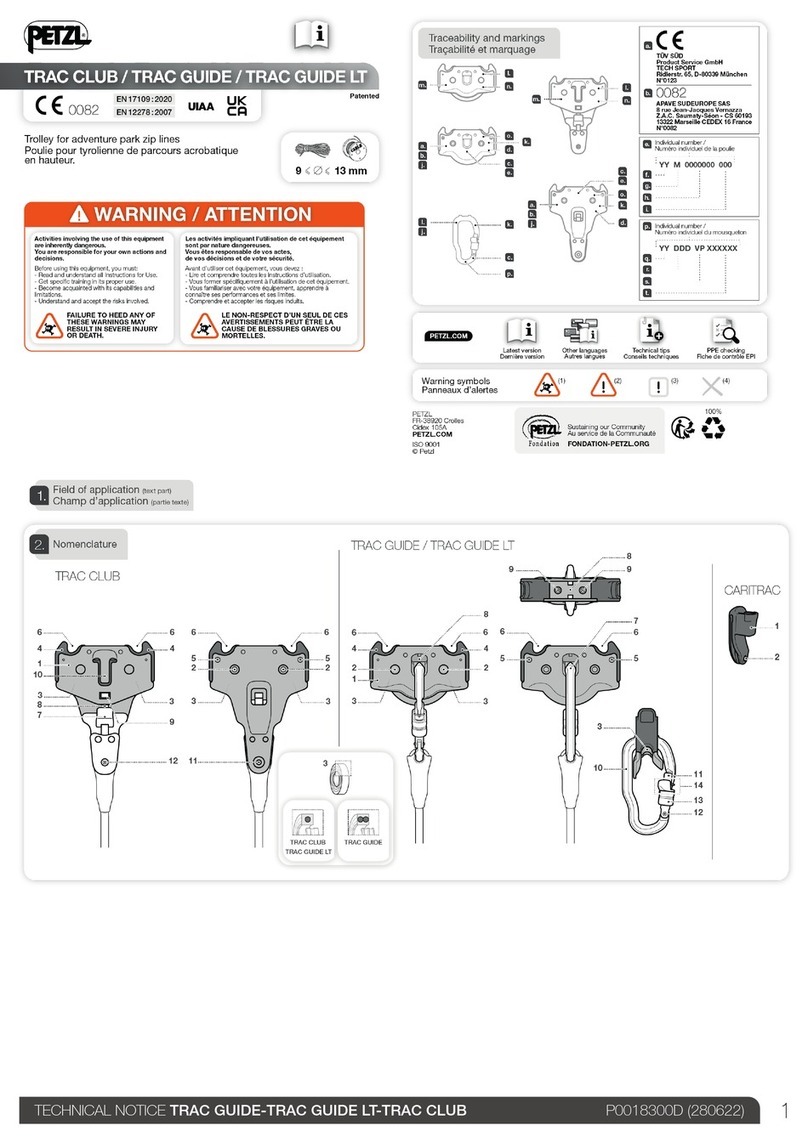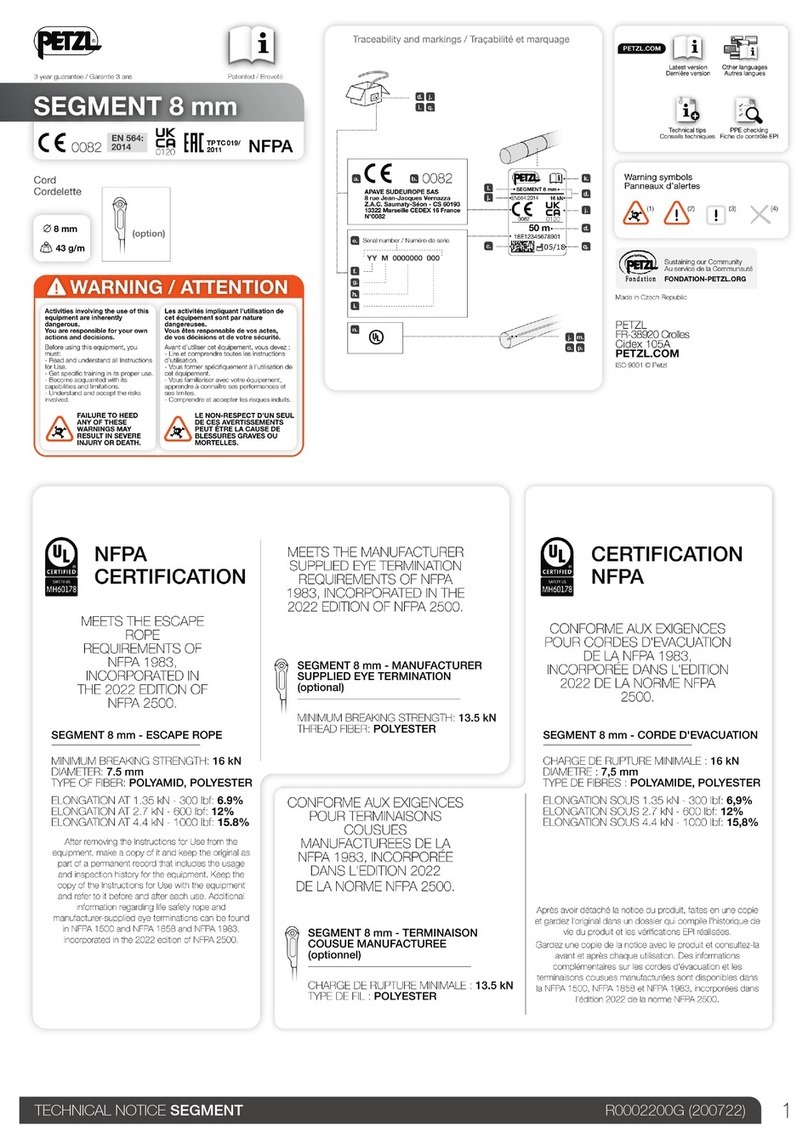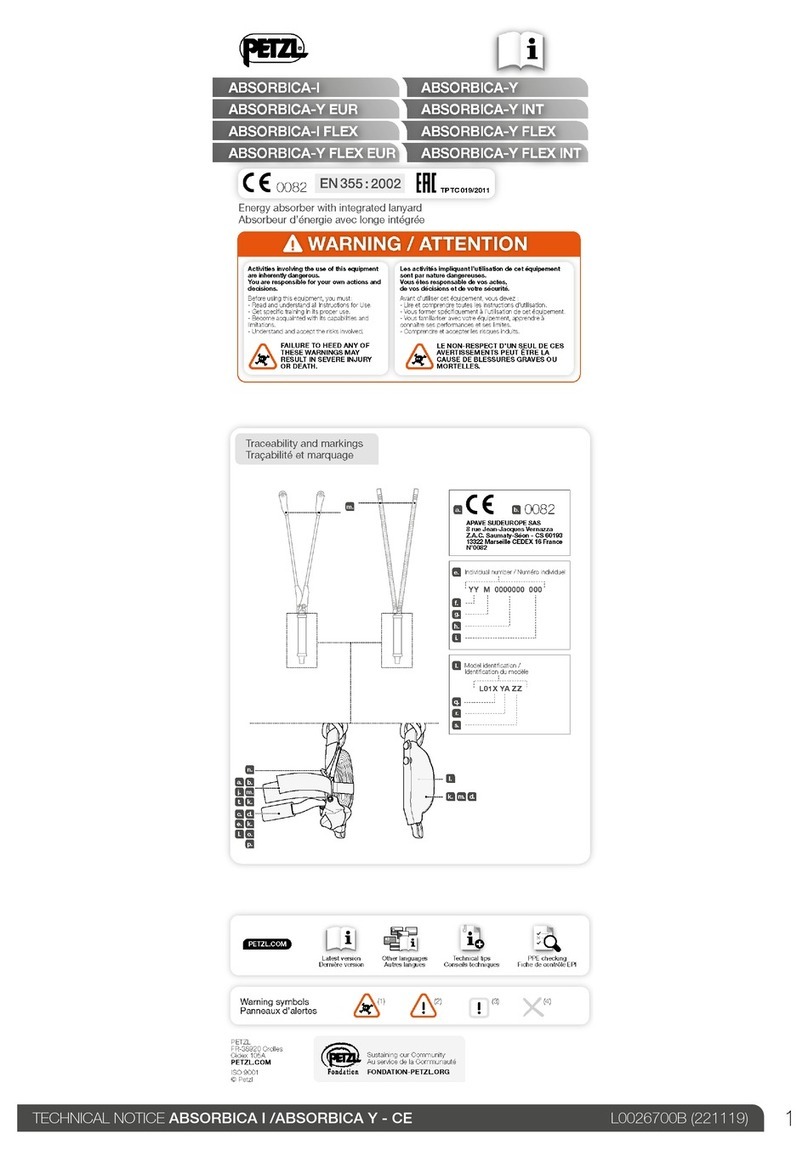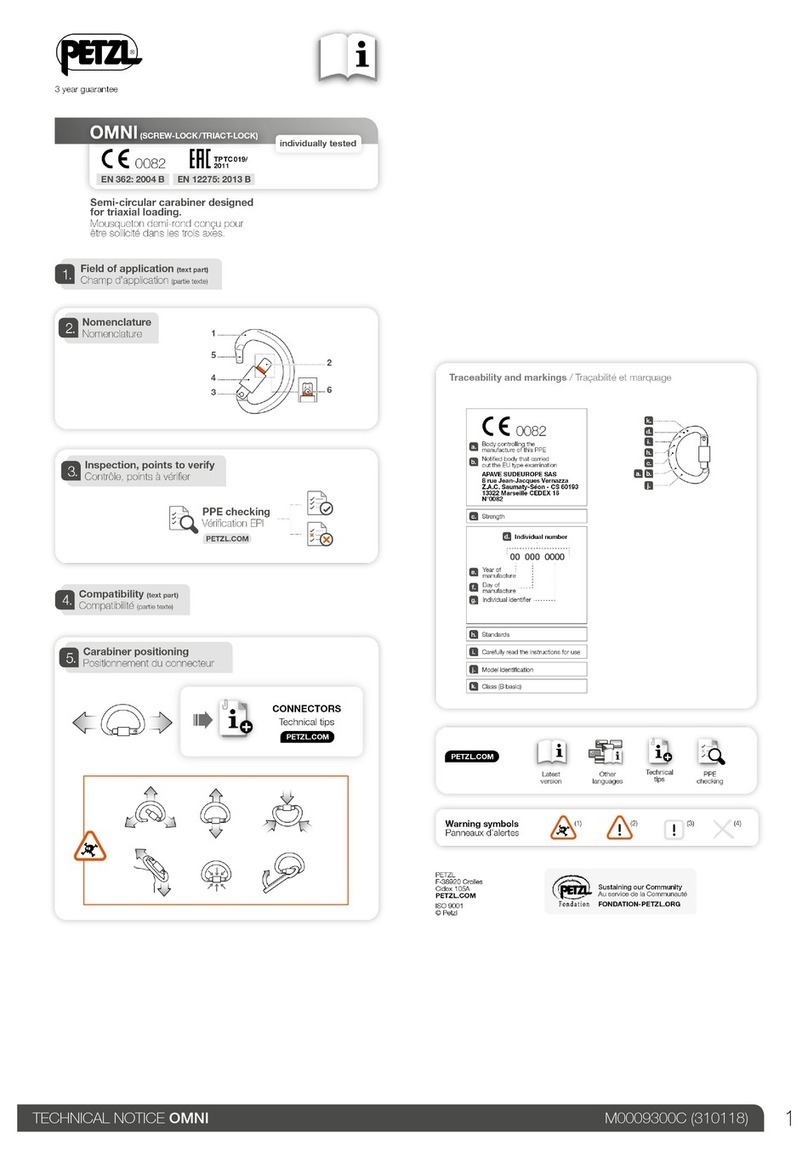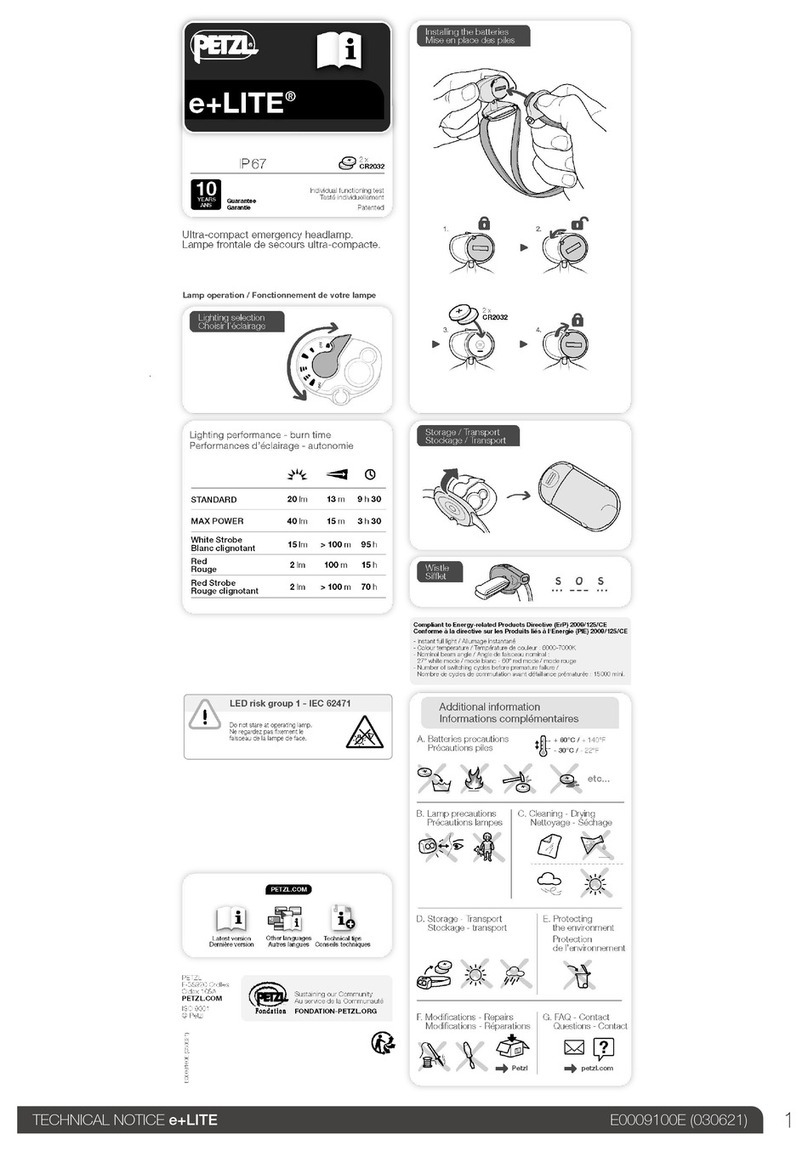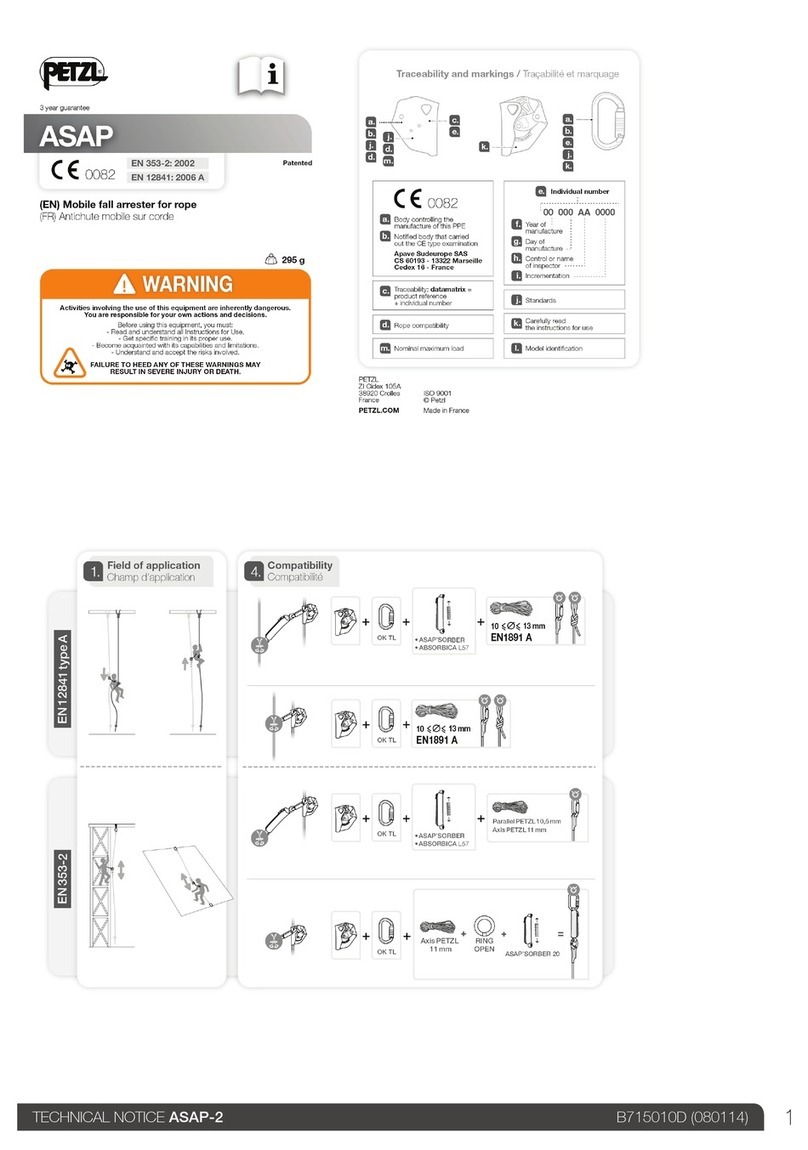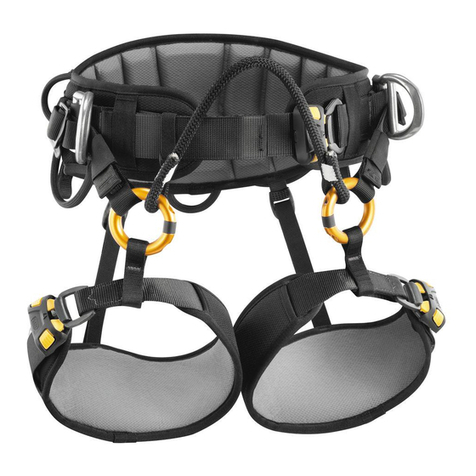
TECHNICAL NOTICE - B17 ASCENSION B175100D (171114)
4
DE
In dieser Gebrauchsanweisung wird erklärt, wie Sie Ihr Produkt richtig verwenden. Es werden
nur einige der Techniken und Verwendungen dargestellt.
Die Warnhinweise informieren Sie über gewisse mögliche Gefahren bezüglich der Verwendung
Ihres Produkts. Es ist jedoch nicht möglich, alle erwägbaren Fälle zu beschreiben. Bitte
nehmen Sie Kenntnis von den Aktualisierungen und zusätzlichen Informationen auf Petzl.com.
Sie sind für die Beachtung der Warnhinweise und für die sachgemäße Verwendung Ihres
Produkts verantwortlich. Jede fehlerhafte Verwendung des Produkts bedeutet eine zusätzliche
Gefahrenquelle. Wenn Sie Zweifel haben oder etwas nicht richtig verstehen, wenden Sie sich
bitte an Petzl.
1. Bestimmungsgemäßer Gebrauch
Persönliche Schutzausrüstung (PSA).
Handsteigklemme.
- Seilklemme zum Bergsteigen und Klettern (EN 567: 2013)
- Vorrichtung für den Aufstieg am Arbeitsseil (EN 12841: 2006 Typ B)
Dieses Produkt darf nicht über seine Grenzen hinaus belastet werden. Es darf ausschließlich zu
dem Zweck verwendet werden, für den es entworfen wurde.
Haftung
WARNUNG
Aktivitäten, bei denen diese Ausrüstung zum Einsatz kommt, sind
naturgemäß gefährlich.
Für Ihre Handlungen, Entscheidungen und für Ihre Sicherheit sind Sie selbst
verantwortlich.
Vor dem Gebrauch dieser Ausrüstung müssen Sie:
- Die Gebrauchsanleitung vollständig lesen und verstehen.
- Fachgerecht zur richtigen Benutzung der Ausrüstung ausgebildet sein.
- Sich mit Ihrer Ausrüstung vertraut machen, die Möglichkeiten und Einschränkungen kennen
lernen.
- Die mit dem Einsatz verbundenen Risiken verstehen und akzeptieren.
Die Nichtberücksichtigung auch nur einer dieser Warnungen kann zu
schweren Verletzungen oder sogar Tod führen.
Dieses Produkt darf nur von kompetenten und besonnenen Personen verwendet werden oder
von Personen, die unter der direkten Aufsicht und visuellen Kontrolle einer kompetenten und
besonnenen Person stehen.
Sie sind für Ihre Handlungen, Entscheidungen und für Ihre Sicherheit verantwortlich und tragen
die Konsequenzen. Wenn Sie nicht in der Lage sind, diese Verantwortung zu übernehmen,
oder wenn Sie die Gebrauchshinweise nicht richtig verstanden haben, benutzen Sie diese
Ausrüstung nicht.
2. Benennung der Teile
(1) Obere Befestigungsöse, (2) Klemmnocken, (3) Sicherheitssperre, (4) Untere
Befestigungsöse, (5) Griff.
Materialien: Aluminiumlegierung, Edelstahl, technischer Kunststoff.
3. Überprüfung, zu kontrollierende Punkte
Ihre Sicherheit hängt vom Zustand Ihrer Ausrüstung ab.
Petzl empfiehlt, mindestens alle 12 Monate (entsprechend den in Ihrem Land geltenden
Vorschriften und den Nutzungsbedingungen) eine eingehende Überprüfung durch eine
kompetente Person durchführen zu lassen. Bitte beachten Sie die auf petzl.com/de/psa
beschriebenen Vorgehensweisen. Tragen Sie die Ergebnisse in den Prüfbericht Ihrer PSA ein:
Typ, Modell, Kontaktinformation des Herstellers, Seriennummer oder individuelle Nummer,
Daten: Herstellung, Kauf, erste Anwendung, nächste regelmäßige Überprüfung, Probleme,
Bemerkungen, Name und Unterschrift des Prüfers.
Vor jedem Einsatz
Überprüfen Sie das Produkt auf Risse, Deformierungen, Kratzer, Abnutzungs- und
Korrosionserscheinungen usw.
Überprüfen Sie den Zustand von Körper, Befestigungsösen, Klemmnocken und
Sicherheitssperre, Nieten, Nockenfedern und Achse.
Überprüfen Sie die Gängigkeit des Klemmmechanismus und kontrollieren Sie, ob die
Rückholfeder einwandfrei funktioniert.
Vergewissern Sie sich, dass die Zähne des Klemmnockens nicht verschmutzt sind.
ACHTUNG: Verwenden Sie keine Seilklemme mit abgenutzten oder fehlenden Zähnen.
Während des Gebrauchs
Es ist unerlässlich, den Zustand des Produkts und seiner Verbindungen mit anderen
Ausrüstungsgegenständen im System regelmäßig zu überprüfen. Stellen Sie stets sicher, dass
die einzelnen Ausrüstungsgegenstände im System richtig zueinander positioniert sind.
ACHTUNG:
- Stellen Sie sicher, dass keine Fremdkörper die Funktion des Nockens beeinträchtigen
- und dass sich keine Gegenstände an der Sicherheitssperre verfangen und somit die Öffnung
des Klemmnockens bewirken können.
4. Kompatibilität
Überprüfen Sie die Kompatibilität dieses Produkts mit den anderen Elementen Ihres Systems
(Kompatibilität = funktionelles Zusammenspiel).
Die mit Ihrer ASCENSION-Handsteigklemme verwendeten Ausrüstungselemente müssen
mit den in Ihrem Land geltenden Normen übereinstimmen (z.B. Karabiner EN 12275 für die
Verwendung beim Klettern/Bergsteigen oder EN 362 in der Industrie). Achten Sie darauf, dass
die Karabiner mit der Seilklemme (Form, Abmessungen usw.) kompatibel sind.
5. Bedienung und Funktionsprüfung
In einer Richtung rutscht die ASCENSION-Handsteigklemme am Seil entlang und in der
anderen Richtung blockiert sie.
Zuerst greifen die Zähne des Klemmnockens in das Seil, welches dann durch den
Klemmnocken blockiert wird. Stellen Sie beim Anbringen des Geräts am Seil sicher, dass das
Gerät in die gewünschte Richtung blockiert.
6. Installation der ASCENSION
Beachten Sie die Kennzeichnung für oben und unten.
Entfernen des Seils
Schieben Sie das Gerät am Seil nach oben, während Sie die Sicherheitssperre mit Daumen
und Zeigefinger nach unten und außen ziehen.
7. Aufstieg am Seil
a. Das Gerät muss parallel zum Seil belastet werden. Um das Durchrutschen der Seilklemme
an einem Seil zu verhindern, darf sie nicht abgewinkelt zum Seil belastet werden.
b. Wenn sich eine abgewinkelte Belastung zum Seil nicht vermeiden lässt, sichern Sie das Seil
mit dem Karabiner Ihres Verbindungsmittels.
c. Steigen Sie nicht über die Seilklemme oder den Fixpunkt hinaus und achten Sie darauf, dass
Ihr Verbindungsmittel gestrafft ist.
In der Nähe des Fixpunktes ist keine Sturzbelastung zulässig.
8. EN 12841 Typ B - zusätzliche Informationen
Die ASCENSION-Handsteigklemme muss zusammen mit einem
Rücksicherungssystem Typ A am Sicherheitsseil verwendet werden.
- Die ASCENSION ist nicht als Bestandteil eines Auffangsystems geeignet.
- Verwenden Sie in Übereinstimmung mit den Anforderungen der Norm EN 12841: 2006 Typ
B halbstatische Seile (Kern + Mantel) gemäß EN 1891 Typ A mit 10 bis 13 mm Durchmesser.
(Anmerkung: Die Zertifizierungsprüfungen werden mit den Seilen BEAL Antipodes 10 mm und
Petzl GRIP 12,5 mm durchgeführt.)
- Verwenden Sie ein Verbindungssystem mit einer maximalen Länge von 1 Meter
(Verbindungsmittel + Karabiner + Geräte). Beachten Sie die empfohlene maximale Länge.
- Das Seil muss zwischen der Seileinstellvorrichtung und dem Fixpunkt immer straff gespannt
sein, um das Sturzrisiko zu begrenzen.
Wenn Sie an Ihrem Arbeitsseil hängen, achten Sie darauf, dass das Sicherungsseil nicht
belastet ist.
Eine dynamische Überlast kann das Führungsseil beschädigen.
Maximale Arbeitslast: 140 kg.
9. Zusätzliche Informationen
- Der Benutzer muss für eventuelle Schwierigkeiten, die während der Anwendung dieses
Produkts auftreten können, Rettungsmöglichkeiten planen.
- Der Fixpunkt des Systems muss oberhalb des Benutzers angebracht sein und den
Anforderungen der Norm EN 795 entsprechen. Die Mindestbruchlast des Fixpunktes muss
12 kN betragen.
- In einem Auffangsystem ist vor jeder Benutzung sicherzustellen, dass genügend Sturzraum
unter dem Anwender vorhanden ist, so dass er im Falle eines Sturzes nicht auf den Boden
oder auf ein Hindernis schlägt.
- Achten Sie darauf, dass der Fixpunkt richtig platziert ist, um das Risiko und die Höhe eines
Sturzes zu reduzieren.
- In einem Auffangsystem ist zum Halten des Körpers ausschließlich ein Auffanggurt zulässig.
- Werden mehrere Ausrüstungsgegenstände zusammen verwendet, kann es zu gefährlichen
Situationen kommen, wenn die Sicherheitsfunktion eines Gegenstands durch einen anderen
Ausrüstungsgegenstand behindert wird.
- ACHTUNG GEFAHR: Achten Sie darauf, dass die Produkte nicht an rauen Materialien oder
scharfkantigen Gegenständen reiben.
- Anwender müssen für Aktivitäten in der Höhe gesundheitlich in guter Verfassung sein.
WARNUNG, das regungslose Hängen in einem Gurt kann zu schweren Verletzungen oder
sogar Tod führen (Hängetrauma!).
- Die Gebrauchsanleitungen für jeden Ausrüstungsgegenstand, der zusammen mit diesem
Produkt verwendet wird, müssen unbedingt befolgt werden.
- Die Gebrauchsanleitungen in Landessprache müssen allen Benutzern dieser Ausrüstung zur
Verfügung gestellt werden.
- Vergewissern Sie sich, dass die Markierungen auf dem Produkt lesbar sind.
Aussondern von Ausrüstung:
ACHTUNG, außergewöhnliche Umstände können die Aussonderung eines Produkts
nach einer einmaligen Anwendung erforderlich machen (Art und Intensität der Benutzung,
Anwendungsbereich: aggressive Umgebungen, Meeresklima, scharfe Kanten, extreme
Temperaturen, Chemikalien usw.).
In folgenden Fällen muss ein Produkt ausgesondert werden:
- Nach einem schweren Sturz (oder Belastung).
- Das Überprüfungsergebnis ist nicht zufriedenstellend, das Produkt fällt bei der Überprüfung
durch. Sie bezweifeln seine Zuverlässigkeit.
- Die vollständige Gebrauchsgeschichte ist nicht bekannt.
- Das Produkt ist veraltet (Änderung der gesetzlichen Bestimmungen, der Normen und der
technischen Vorschriften, Inkompatibilität mit anderen Ausrüstungsgegenständen usw.).
Zerstören und entsorgen Sie diese Produkte, um ihren weiteren Gebrauch zu verhindern.
Zeichenerklärungen:
A. Unbegrenzte Lebensdauer - B. Temperaturbeständigkeit - C. Vorsichtsmaßnahmen
- D. Reinigung - E. Trocknung - F. Lagerung/Transport - G. Pflege - H. Änderungen/
Reparaturen (außerhalb der Petzl Betriebsstätten nicht zulässig, ausgenommen Ersatzteile) - I.
Fragen/Kontakt
3 Jahre Garantie
Auf Material- und Fabrikationsfehler. Von der Garantie ausgeschlossen sind: normale
Abnutzung, Oxidation, Änderungen oder Nachbesserungen, unsachgemäße Lagerung,
unsachgemäße Wartung, Nachlässigkeiten und Anwendungen, für die das Produkt nicht
bestimmt ist.
Warnhinweise
1. Unmittelbare Verletzungs- oder Lebensgefahr. 2. Potenzielles Unfall- oder Verletzungsrisiko.
3. Wichtige Information über die Funktionsweise oder die Leistungsangaben Ihres Produkts. 4.
Inkompatibilität zwischen Ausrüstungsgegenständen.
Rückverfolgbarkeit und Markierung
a. Die Herstellung dieser PSA überwachende Stelle - b. Benannte Stelle für die EG-
Baumusterprüfung - c. Rückverfolgbarkeit: Data Matrix = Artikelnummer + individuelle Nummer
- d. Durchmesser - e. Individuelle Nummer - f. Herstellungsjahr - g. Herstellungstag - h.
Prüfung oder Name des Prüfers - i. Fortlaufende Seriennummer - j. Normen - k. Lesen Sie die
Gebrauchsanleitung aufmerksam durch - l. Modell-Identifizierung - m. Maximale Arbeitslast -
n. Benutzungsrichtung - o. Typ B: Typ der Seileinstellvorrichtung EN 12841 - p. Seil EN 1891
Typ A für EN 12841
IT
Questa nota informativa spiega come utilizzare correttamente il dispositivo. Solo alcune
tecniche e utilizzi sono presentati.
I segnali di attenzione vi informano di alcuni potenziali pericoli legati all’utilizzo del dispositivo,
ma è impossibile descriverli tutti. Prendete visione degli aggiornamenti e delle informazioni
supplementari sul sito Petzl.com.
Voi siete responsabili della considerazione di ogni avviso e dell’utilizzo corretto del dispositivo.
L’uso improprio di questo dispositivo causa rischi aggiuntivi. Contattare Petzl in caso di dubbi
o difficoltà di comprensione.
1. Campo di applicazione
Dispositivo di protezione individuale (DPI).
Maniglia bloccante.
- Bloccante d’alpinismo e arrampicata (EN 567: 2013).
- Dispositivo di salita per supporto di lavoro (EN 12841 tipo B: 2006).
Questo prodotto non deve essere sollecitato oltre i suoi limiti o in qualsiasi altra situazione
differente da quella per cui è destinato.
Responsabilità
ATTENZIONE
Le attività che comportano l’utilizzo di questo dispositivo sono per natura
pericolose.
Voi siete responsabili delle vostre azioni, delle vostre decisioni e della vostra
sicurezza.
Prima di utilizzare questo dispositivo, occorre:
- Leggere e comprendere tutte le istruzioni d’uso.
- Ricevere una formazione adeguata sul suo utilizzo.
- Acquisire familiarità con il dispositivo, imparare a conoscerne le prestazioni e i limiti.
- Comprendere e accettare i rischi indotti.
Il mancato rispetto di una sola di queste avvertenze può essere la causa di
ferite gravi o mortali.
Questo prodotto deve essere utilizzato esclusivamente da persone competenti e addestrate o
sottoposte al controllo visivo diretto di una persona competente e addestrata.
Voi siete responsabili delle vostre azioni, delle vostre decisioni e della vostra sicurezza e ve ne
assumete le conseguenze. Se non siete in grado di assumervi questa responsabilità, o se non
avete compreso le istruzioni d’uso, non utilizzare questo dispositivo.
2. Nomenclatura
(1) Foro superiore, (2) Fermacorda, (3) Leva di sicurezza, (4) Foro di collegamento inferiore,
(5) Maniglia.
Materiali principali: lega d’alluminio, acciaio inossidabile, plastica tecnica.
3. Controllo, punti da verificare
La vostra sicurezza è legata all’integrità della vostra attrezzatura.
Petzl raccomanda un controllo approfondito come minimo ogni 12 mesi da parte di una
persona competente (in funzione della normativa in vigore nel vostro paese e delle vostre
condizioni d’uso). Rispettate le procedure descritte sul sito www.petzl.com/it/verifica-dpi.
Registrate i risultati nella scheda di vita del vostro DPI: tipo, modello, dati del fabbricante,
numero di serie o numero individuale; date: fabbricazione, acquisto, primo utilizzo, successive
verifiche periodiche; difetti, osservazioni; nome e firma del controllore.
Prima di ogni utilizzo
Verificare sul prodotto l’assenza di fessurazioni, deformazioni, segni, usura, corrosione...
Verificare lo stato del corpo, dei fori di collegamento, del fermacorda e della leva di sicurezza, i
rivetti, le molle e l’asse del fermacorda.
Controllare la mobilità del fermacorda e l’efficacia della sua molla.
Verificare che i denti del fermacorda non siano sporchi.
ATTENZIONE, se mancano dei denti o se sono usurati, non utilizzare più questo bloccante.
Durante l’utilizzo
È importante controllare regolarmente lo stato del prodotto e dei suoi collegamenti con gli altri
dispositivi del sistema. Assicurarsi del corretto posizionamento dei dispositivi gli uni rispetto
agli altri.
ATTENZIONE:
- agli oggetti estranei che rischiano di ostacolare il funzionamento del fermacorda,
- agli elementi che rischiano di agganciarsi sulla leva, provocando l’apertura del fermacorda.
4. Compatibilità
Verificare la compatibilità di questo prodotto con gli altri elementi del sistema nella vostra
applicazione (compatibilità = buona interazione funzionale).
Gli elementi utilizzati con l’ASCENSION devono essere conformi alle norme in vigore nel vostro
paese (per esempio moschettoni EN 12275 per l’utilizzo in arrampicata/alpinismo) o EN 362
nell’industria). Verificare la compatibilità connettori/bloccante (forme, dimensioni…).
5. Principio e test di funzionamento
L’ASCENSION scorre lungo la corda in un senso, mentre nell’altro blocca.
I denti del fermacorda avviano il serraggio permettendo così al fermacorda di bloccare la corda
stringendola. Ad ogni sistemazione sulla corda, verificare che l’apparecchio blocchi nel senso
desiderato.
6. Installazione dell’ASCENSION
Rispettare l’indicazione Alto e Basso.
Per togliere la corda
Far scorrere l’apparecchio sulla corda verso l’alto e contemporaneamente togliere il
fermacorda azionando la leva.
7. Risalita su corda
a. La trazione deve essere fatta nella giusta posizione verso il basso parallelamente alla corda.
Per evitare che il bloccante scorra sulla corda, la trazione non deve essere fatta in modo
obliquo rispetto alla corda.
b. Se non si può evitare una trazione obliqua rispetto alla corda, assicurare quest’ultima con il
connettore della longe.
c. Non salire al di sopra del bloccante o del punto di ancoraggio e tenere il cordino in tensione.
Nessuno choc tollerato quando vi avvicinate al punto di ancoraggio.
8. EN 12841 tipo B - informazioni
supplementari
L’ASCENSION deve essere utilizzato con un dispositivo di autoassicurazione
di tipo A sulla fune di sicurezza.
- L’ASCENSION non è adatto ad un utilizzo in un sistema anticaduta.
- Per rispondere ai requisiti della norma EN 12841: 2006 tipo B, utilizzare delle corde
semistatiche (anima + calza) EN 1891 tipo A da 10 a 13 mm di diametro. (Nota: al momento
della certificazione, test effettuati su corde Antipodes BEAL 10 mm e GRIP Petzl 12,5 mm).
- Utilizzare un sistema di collegamento di 1 metro di lunghezza massima (cordino + connettori
+ apparecchi). Assicurarsi di rispettare la lunghezza massima raccomandata.
- La corda deve sempre essere tesa tra il dispositivo di regolazione e l’ancoraggio per limitare
il rischio di caduta.
Quando si è in tensione sul proprio supporto di lavoro, assicurarsi che il proprio supporto di
sicurezza non sia caricato.
Un sovraccarico dinamico può danneggiare i supporti d’assicurazione.
Carico nominale massimo: 140 kg.
9. Informazioni supplementari
- Prevedere i mezzi di soccorso necessari per intervenire rapidamente in caso di difficoltà.
- L’ancoraggio del sistema deve essere preferibilmente situato al di sopra della posizione
dell’utilizzatore e deve rispondere ai requisiti della norma EN 795 (resistenza minima 12 kN).
- In un sistema di arresto caduta, prima di ogni utilizzo, è fondamentale verificare lo spazio
libero richiesto sotto l’utilizzatore, per evitare la collisione con il suolo o un ostacolo in caso
di caduta.
- Assicurarsi che il punto di ancoraggio sia posizionato correttamente, per ridurre il rischio e
l’altezza di caduta.
- Un’imbracatura anticaduta è l’unico dispositivo di presa del corpo che sia consentito utilizzare
in un sistema di arresto caduta.
- Un pericolo può sopraggiungere al momento dell’utilizzo di più dispositivi in cui la funzione
di sicurezza di uno dei dispositivi può essere compromessa dalla funzione di sicurezza di un
altro dispositivo.
- ATTENZIONE PERICOLO, verificare che i prodotti non sfreghino contro materiali abrasivi o
parti taglienti.
- Gli utilizzatori devono avere l’idoneità sanitaria per le attività in quota. ATTENZIONE, la
sospensione inerte nell’imbracatura può generare gravi disturbi fisiologici o la morte.
- Devono essere rispettate le istruzioni d’uso indicate nelle note informative di ogni dispositivo
associato a questo prodotto.
- Le istruzioni d’uso di questo dispositivo devono essere fornite all’utilizzatore e redatte nella
lingua del paese in cui il prodotto viene utilizzato.
- Assicurarsi che le marcature sul prodotto siano leggibili.
Eliminazione:
ATTENZIONE, un evento eccezionale può comportare l’eliminazione del prodotto dopo un solo
utilizzo (tipo ed intensità di utilizzo, ambiente di utilizzo: ambienti aggressivi, ambiente marino,
parti taglienti, temperature estreme, prodotti chimici...).
Il prodotto deve essere eliminato quando:
- Ha subito una forte caduta (o sforzo).
- Il risultato dei controlli del prodotto non è soddisfacente. Si ha un dubbio sulla sua affidabilità.
- Non si conosce l’intera storia del suo utilizzo.
- Quando il suo utilizzo è obsoleto (evoluzione delle leggi, delle normative, delle tecniche o
incompatibilità con altri dispositivi...).
Distruggere i prodotti scartati per evitarne un futuro utilizzo.
Pittogrammi:
A. Durata illimitata - B. Temperature tollerate - C. Precauzioni d’uso - D. Pulizia - E.
Asciugatura - F. Stoccaggio/trasporto - G. Manutenzione - H. Modifiche/riparazioni
(proibite al di fuori degli stabilimenti Petzl salvo pezzi di ricambio) - I. Domande/contatto
Garanzia 3 anni
Contro ogni difetto di materiale o di fabbricazione. Sono esclusi: usura normale, ossidazione,
modifiche o ritocchi, cattiva conservazione, manutenzione impropria, negligenze, utilizzi ai quali
questo prodotto non è destinato.
Segnali di attenzione
1. Situazione che presenta un rischio imminente di lesione grave o mortale. 2. Esposizione a
un rischio potenziale d’incidente o lesione. 3. Informazione importante sul funzionamento o le
performance del vostro prodotto. 4. Incompatibilità materiale.
Tracciabilità e marcatura
a. Organismo che controlla la fabbricazione di questo DPI - b. Ente riconosciuto che interviene
per l’esame CE di tipo - c. Tracciabilità: datamatrix = codice prodotto + numero individuale - d.
Diametro - e. Numero individuale - f. Anno di fabbricazione - g. Giorno di fabbricazione - h.
Controllo o nome del controllore - i. Incrementazione - j. Norme - k. Leggere attentamente
l’istruzione tecnica - l. Identificazione di modello - m. Carico nominale massimo - n. Senso di
utilizzo - o. Tipo B: tipo di dispositivo di regolazione EN 12841 - p. Supporto EN 1891 tipo A
per EN 12841
